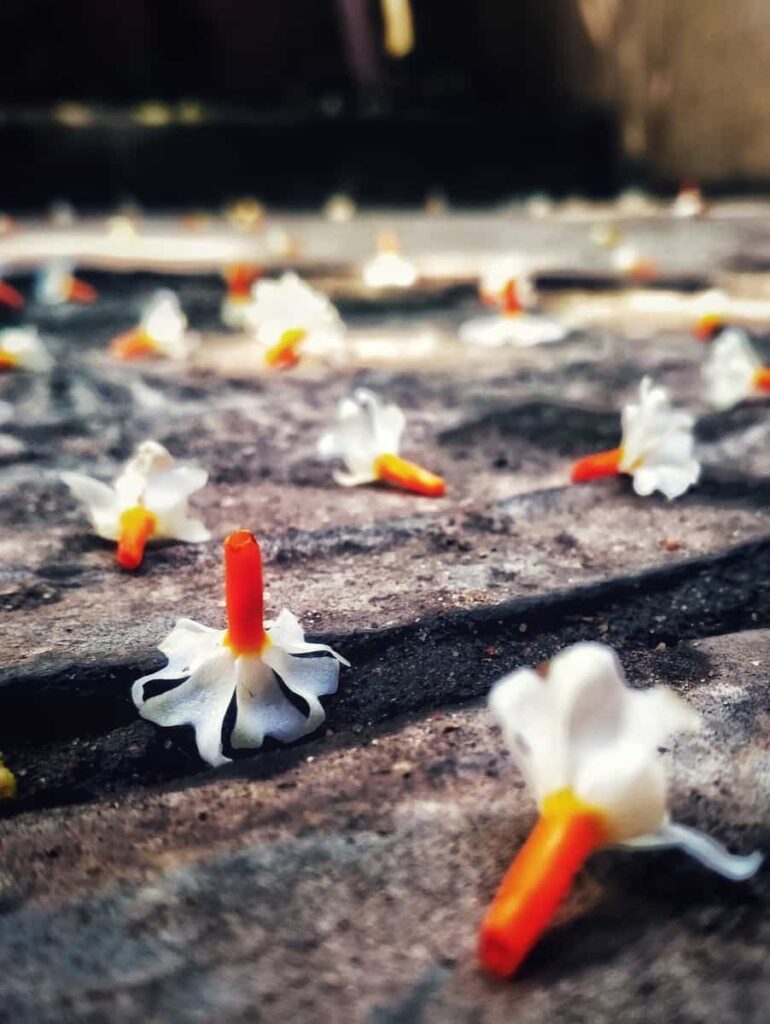The Parijat flower is botanically called Nyctanthes arbor-tristis. The plant is also called night jasmine and coral jasmine in English. This is due to the unique flowering habit of the plant. Parijat belongs to the Oleaceae family. The flowers have four to eight petals arranged in a pinwheel pattern above a vibrant orange tube.
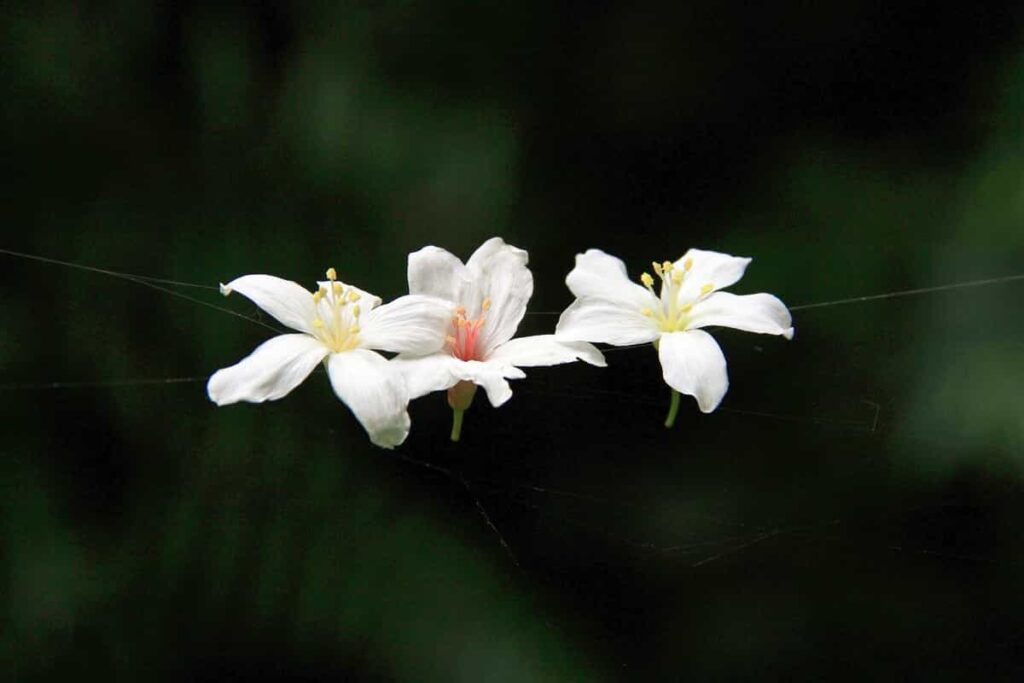
The Parijat flower is white. It has eight petals arranged evenly from an orange stem. It comes with a sweet and light fragrance that fills the surroundings. Fallen flowers enhance the beauty of the ground. These Parijat flowers spread the fragrance to its surrounding area with a strong sweet floral aroma. Let’s check out how to grow Parijat plant (Harsingar) below.
| Common names | Parijat, Parijata Night-Flowering Jasmine Coral Jasmine |
| Maximum | Reachable height up to 10 meters |
| Flower color | White |
| Bloom time | August to December |
| Difficulty level | Easy to grow |
How to grow Parijat plant (Harsingar)
Germination time for Parijat seeds
Fill a container with seed starter mix, and sow the seeds 2 cm deep. Mist the soil and then place it in bright but indirect sunlight. The seeds will germinate in 3-4 weeks.
Reasons for Parijat plant not flowering
Give it lots of direct sunlight
The first reason is too much sunlight. All it needed was morning sunlight. If your plant receives sunlight all day, you need to move it as soon as possible. You must keep the plant in a shady place for the rest of the day. This plant only needs direct sunlight (morning sunlight), so if your plant is placed in a location where it receives direct sunlight all day, consider relocating if sunlight is available. Or if it is kept in a shady place, even the Parijat plant will not be able to flower. The key here is to provide direct sunlight in the morning and bright indirect sunlight throughout the day.
In case you missed it: Garden Planting Calendar in India: Month-wise Chart and Guide for Fruits, Flowers, Herbs, and Vegetables
Lack of fertilizer
Another reason for the non-flowering of the Parijat plant is the lack of fertilizer. It is a large tree and needs adequate fertilizer to grow flowers and leaves. Before the seasoning season of parsnips, you need to add compost to provide all the nutrients for the flowers.
Overwatering
The third reason is a mistake in the watering routine. You need to avoid standing water as much as possible. Overwatering can cause root rot and may not produce flowers. The biggest threat to the Parijat plant is standing water, which causes root rot. Your plant may suffer from this, and you don’t know why it won’t flower.
Just check your soil and see if it is wet and soggy; your plant is either in the process of root rot or has already rotted. Keep the soil moist at all times. The best way to do this is to touch up the topsoil and water the plant when it feels dry. Avoid wetting the leaves to avoid fungal problems.
Soil requirement for growing Parijat flowers
Parijat prefers well-drained, moist and aerated soil. However, you can go for a loamy to sandy soil well amended with organic matter. You can prepare a mixture by mixing equal parts of garden soil, coarse sand, vermicompost, or cow dung compost. Use well-drained, moist, loose, and fertile soil. Amend it with organic matter like vermiculture, compost, or aged cow dung compost. For containers, use any standard potting mix available for potted plants. You can also mix soil with equal parts of garden soil, coarse sand, and cow dung compost.
Prepare a potting mix with 50% normal garden soil + 30% organic fertilizer like vermicompost, mix it well, and fill a 12-inch growing container with 3 to 4 good drainage holes. Plant new saplings in this pot and cover the base of the plant with potting mix. Apply firm pressure around the base to fix the plant properly. Water the pot and place it in the shade for at least ten days until the plant adjusts to the new environment.
Parijat blooming time
The flowering time of the Parijat flower in India is from August to November. Apart from India, the Parijat flowering plant also grows in Nepal, Thailand, Pakistan, and Indonesia.
How to propagate the Parijat plant?
Parijat plants can be propagated by seeds or by stem cuttings. To grow it from seed, prepare a potting mix that contains equal proportions of normal garden soil and compost. After mixing it well, fill the sterile tray with this mixture. The seeds must be sown at a depth of 2 centimeters, and do not put more than one seed in each part of the germination tray. Adequate moisture should be provided, but overwatering should be avoided. Germination starts within 7-14 days of sowing. These plants should be transplanted at the 4 to 5-leaf stage.
In case you missed it: Seed Sowing Chart in India: Schedule Guide and Calendar for Vegetables, Flowers, Herbs, and Fruits
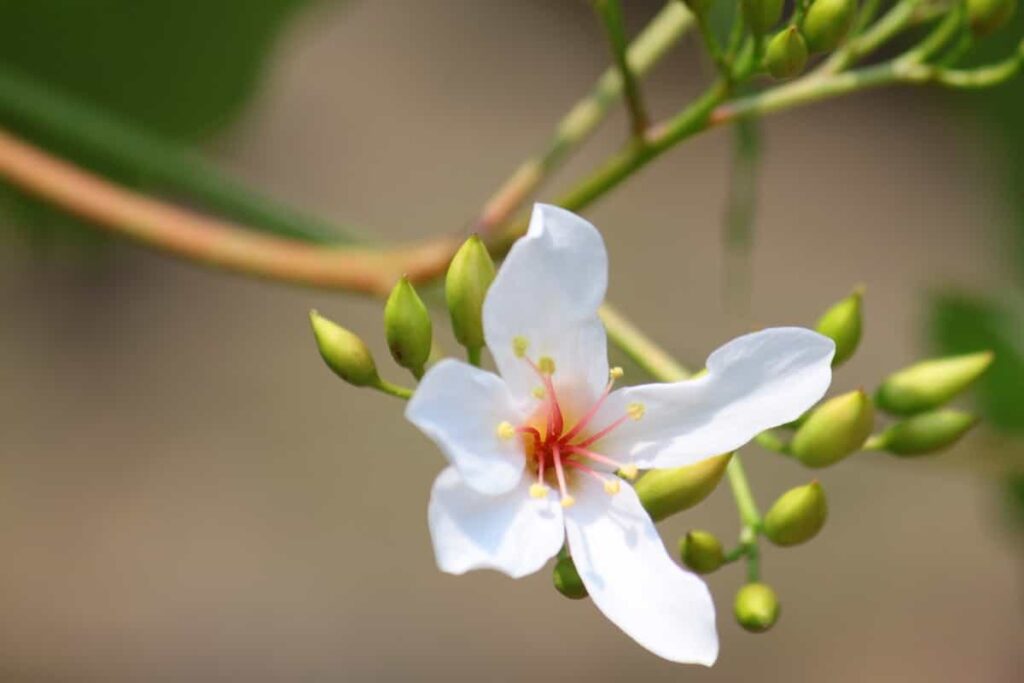
Important requirements to keep the plant healthy
| Sunlight | At least 6 hours of sunlight or at least 6 hours of sunlight and natural light for the rest of the day |
| Watering | Apply 4 cups (Approx. 250 ml) of water when the topsoil (1-2 inches) in the pot feels dry to touch |
| Soil | The soil should be drained-well and should be fertile and rich in organic matter |
| Temperature | 16 to 32 degrees Celsius |
| Fertilizer | Apply organic fertilizer once a month |
How to grow the Parijat plant from seeds?
- To grow a plant in a pot, you need a planter at least 16 inches in diameter. For best results, you should take a clay pot. Make sure there are at least three holes in the bottom of the planter so that excess water can drain out of the pot.
- The best time to plant seeds is in spring. However, you can also propagate it by stem cuttings.
- Do not plant seeds during winter. During this time, the seeds do not germinate. You should also avoid planting trees during this season.
- To prepare the soil, you should take 50% of the garden soil and 50% of any compost, like organic manure or vermicompost. Now mix the soil and compost well. Now fill the pot with the mixture.
- To plant the seeds, you must create and insert a separate section. Again, you must maintain a depth of 2 cm so the plants can emerge easily.
- You need to keep the soil moist but do not overwater it.
Can I grow Parijat from cuttings?
- The first important thing for propagating a Parijat flower plant you need to choose the right stem. The stem should be at least 6-8 inches tall and have at least 4-5 leaves. The color of the stem should be brown. Avoid green and tender stems.
- Cut a cutting 6-8 inches long, just below a node, from a healthy Parijat plant. Leave off all the lower leaves except a few at the top.
- Plant it in a well-draining pot filled with potting mix, and rinse well. Place anywhere with bright and indirect sunlight. Cuttings will root in 3-4 weeks. Finally, you can transfer it to a bigger pot when it outgrows the current pot.
Parijat plant growing in a paper bag system
- For growing Parijat, the paper bag system is the fastest.
- Add 12-15 seeds to a damp paper towel in the paper bag system.
- Place this towel in a zip-lock bag.
- Leave the ziplock pouch in a sunny place.
- After ten days, the seeds will begin to grow.
Growing Parijat plant at home
People think the Parijat flower tree needs much space to grow, but the reality is different. You can grow this tree successfully indoors, but you need to follow a few tips.
- It would help if you chose a clay pot that is 16 inches in diameter and has three holes at the bottom to allow excess water to drain from the pot.
- Spring is the best time to plant Parijat tree seeds. However, you should make sure not to plant these seeds in winter.
- Potting soil should be a mixture of 50% garden soil and 50% organic compost, such as vermicompost. Mix them well.
- Plant one seed in each section and maintain a depth of 2 cm.
- Moisture is good, but don’t overwater.
In case you missed it: Flowers Growing Season Chart in India: Sowing Guide, Germination, and Planting Calendar
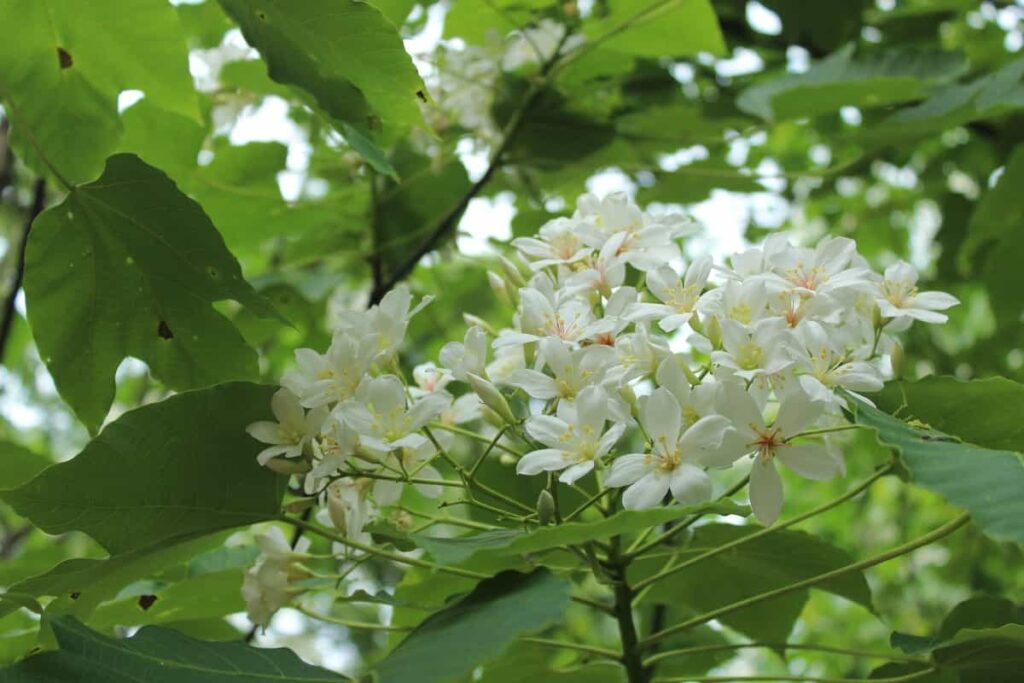
Preparing the container for growing Parijat plants
Take a container about 8 inches and make a drainage hole in the bottom of it. Now fill it with potting mix. The soil for Parijat cuttings needs quick drainage and should have the following ingredients.
- Garden soil – 1/3-part
- 1/3-part cow dung or vermicompost
- 1/3-part river sand
- Add a handful of fungicides
- Once the container is ready
Promoting root growth
Dip the bottom of the cuttings in rooting hormone and then insert them into the soil about 1-1.5 inches deep. And gently press around it. Water well after planting. And now comes the most important part. Cover these potted cuttings with a plastic bag or bottle for a greenhouse effect. And keep it in the shade. After 10-12 days, remove the plastic bottle, and if everything goes well, you will see new life. Then, you can transfer it to a bigger pot whenever it starts outgrowing its current pot.
Fertilizer application for growing Parijat
Feed the Parijat plant with organic fertilizer once a month during the main growing season (August-December). Loosen the topsoil without disturbing the plant’s roots so it can absorb nutrients and moisture easily. Fertilizing plants once a year will be beneficial. Plants require trimming as the shoots grow in different directions. It is best to grow the plant in a shady garden with a few hours of direct sunlight.
Because this plant is so large, it needs a good amount of nutrients to grow well and flower. Therefore, you must provide at least 1 kg of vermicompost (the best compost) or well-rotted home compost twice a year, once in March and again before its flowering season, August. Also, add a handful of Neem Khali (insecticide) to the compost for good results.
Water requirement for Parijat plant growth
Watering a Parijat flower plant is the most important part of taking care of it. Parijat plant does not like to stand in water for long, and if it does, the root will start to rot, and the plant will eventually die. So, whenever you are growing. Parijat tree directly in your land, make sure that the area does not stand water during normal days and the rainy season. And before watering, make sure that the soil is dry and if it is dry, fill it with water so that the water comes out of the drain holes.
Depending on the heat, you may need to water it twice a day during the hot season. Growing it in containers requires well-drained soil so water can drain easily from the pot. Always do a finger test before watering a Parijat plant in a container, i.e., insert your finger 1-2 inches into the potting soil to feel if it is dry. Don’t water it if it’s wet; only water it when it feels dry.
Some quick tips for growing a healthy Parijat tree
- Choose a spot in your garden with at least six hours of sunlight. Parijat, like bougainvillea, hates shade.
- Visit your nearest garden nursery to collect a healthy Parijat plant. You can also ask your gardening friends.
- The plant usually doesn’t require much maintenance, but it’s good if you prune it once a year in the summer. Then, cut off the leaves and branches completely so they can grow back into a healthy plants.
- Do not overwater the plant. Instead, water twice or thrice a day, even in summer. If you plan to use this flower to make a garland or beautify an area, pluck the buds, as the flowers are very delicate.
In case you missed it: Best Place to Buy Plant Seeds Online in India: For Vegetables, Flowers, Fruits, Herbs, and Hybrid Seeds
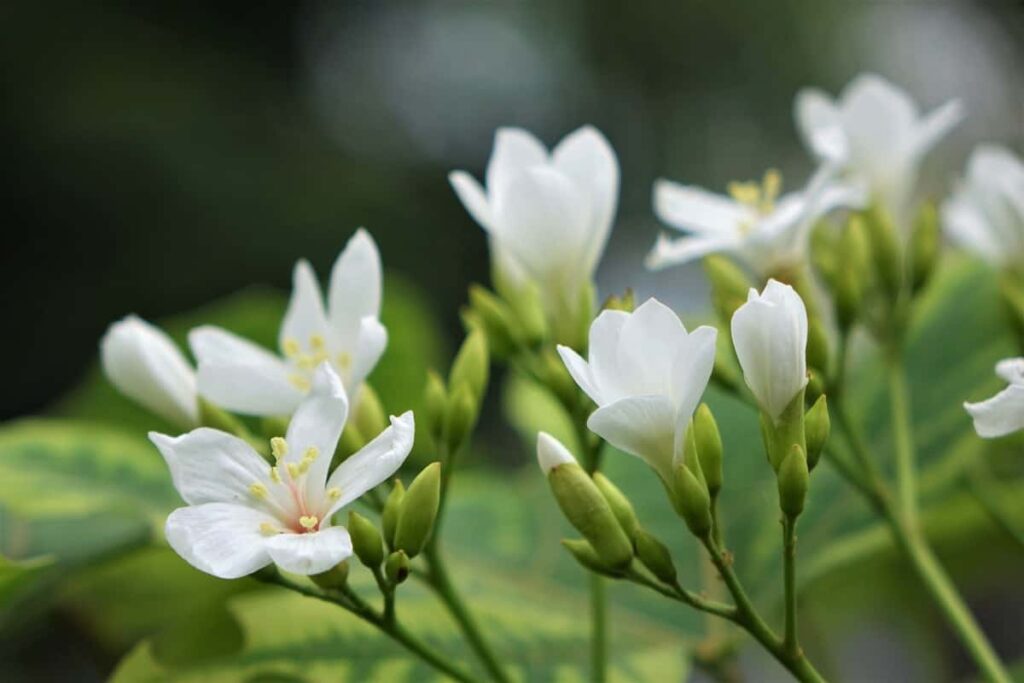
How do you fix yellow leaves in the Parijat plant?
Parijat plants like moisture in the soil, so water it when the surface of the soil is dry. Like other plants, overwatering can harm your Parijat plant; if your plant’s overwatered leaves turn yellow, then turn brown. You also take care not to overwater your plant, which will slow down the growth of your plant or cause it to die due to lack of water. A sign of underwatered Parijat is dropping leaves and browning, so water your plant regularly and reserve the next water when the surface is completely dry.
How to prune Parijat plant?
Periodically prune back criss-cross, dead, and damaged branches to encourage growth. You can also prune the plant in its early stages to give it the desired shape. The plant can grow to an impressive height of 8-10 feet with a spread of 4-6 feet. Finally, prune the Parijat plant in summer before flowering, pruning to get bushy and more flowering.
Pests and diseases management for growing Parijat
- The plant is fairly immune to most pests. Avoid excess water to prevent diseases. Also, do not wet the plants.
- Remove infected, dead, or damaged plant parts and throw them away from the plants.
- For any insect infestation or disease, you can use neem oil, eucalyptus oil, or lemon oil spray as a basic treatment.
- Do not overwater the plant, especially when the pot does not have drainage holes.
- Avoid watering flowers and leaves, as this can lead to fungal infection.
Commonly asked questions about the Parijat plant
Can Parijat grow from cutting?
To grow the Parijat plant from cuttings, you need to get a few cuttings of around 6-8 inches, which are slightly brown. Then, fill a container with fast-draining potting soil and plant the cuttings, covering it with a bag to retain heat and moisture.
Can we grow the Parijat plant at home?
You can grow Parijat at home, but there are some rules and points to remember. Firstly, the earthen pot must be 16 inches in diameter with three drainage holes at the bottom, which is necessary to drain excess water from the pot.
How long does Parijat take to flower?
Its leaves are also useful for treating kidney and bladder diseases. Parijat flowers usually appear five years after planting. This is around the onset of monsoons.
Does the Parijat plant need sunlight?
Yes, the Parijat plant needs sunlight. However, it requires moderate water and does best in the golden morning light.
What do we need before we grow the Parijat plant?
Choose a shady garden area with a few hours of direct sunlight. The shoots of the plant develop in different directions, so you need to trim them.
Where does Parijat grow most?
Parijat thrives within the Outer Himalayas and is found in the Jammu and Kashmir region. Apart from India, it is found in Thailand, Indonesia, Nepal, Pakistan, and Nepal east of Assam, Bengal. Spread from Tripura Central region south to the Godavari.
In case you missed it: Indian Gardening in the USA: For Home, Containers, Backyard, Vegetables, Flowers, Herbs, and Fruits
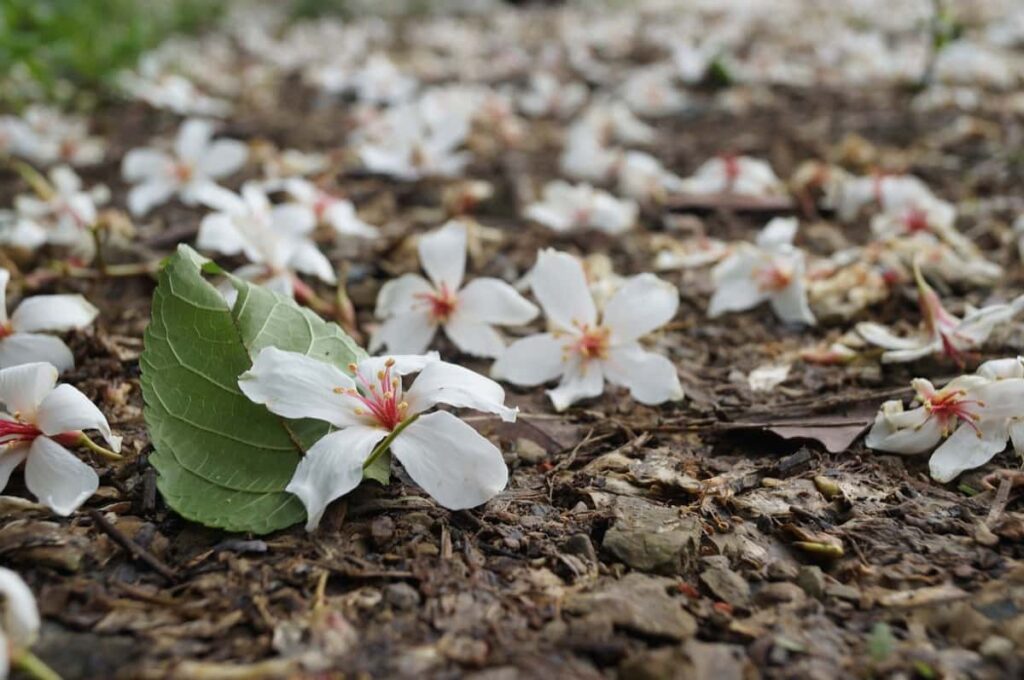
How can I increase the Parijat plant growth?
To care for the plant, provide it with fast-draining potting soil with good nutrients. Grow it in a place with moderate sunlight and water deeply only when the topsoil is a few inches dry. Fertilize in spring and summer.
Conclusion
The Parijat flower is a small shrub with white petaled flowers. This flower is quite popular at night due to its intense fragrance. If you’ve always wanted to grow a plant with fragrance for the whole neighborhood, this is it. Parijat is one of those beautiful and mysterious plants whose flowers fall to the ground after blooming. The flowers bloom at night and fall the branches at the first rays of light.
- Economical Aquaculture: A Guide to Low-Budget Fish Farming
- 15 Common Planting Errors That Can Doom Your Fruit Trees
- How to Make Houseplants Bushy: Effective Tips and Ideas
- Innovative Strategies for Boosting Coconut Pollination and Yield
- Pollination Strategies for Maximum Pumpkin Yield
- The Complete Guide to Chicken Fattening: Strategies for Maximum Growth
- Natural Solutions for Tulip Problems: 100% Effective Remedies for Leaf and Bulb-Related Issues
- Revolutionizing Citrus Preservation: Towards a Healthier, Greener Future
- Natural Solutions for Peony Leaf and Flower Problems: 100% Effective Remedies
- Maximizing Profits with Avocado Contract Farming in India: A Comprehensive Guide
- Natural Solutions for Hydrangea Problems: 100% Effective Remedies for Leaf and Flowers
- The Ultimate Guide to Choosing the Perfect Foliage Friend: Bringing Life Indoors
- From Sunlight to Sustainability: 15 Ways to Use Solar Technology in Agriculture
- The Ultimate Guide to Dong Tao Chicken: Exploring from History to Raising
- The Eco-Friendly Makeover: How to Convert Your Unused Swimming Pool into a Fish Pond
- Mastering the Art of Delaware Chicken Farming: Essentials for Healthy Backyard Flocks
- 20 Best Homemade Fertilizers for Money Plant: DIY Recipes and Application Methods
- How to Craft a Comprehensive Free-Range Chicken Farming Business Plan
- Brighten Your Flock: Raising Easter Egger Chickens for Beauty and Bounty
- How to Optimize Your Poultry Egg Farm Business Plan with These Strategies
- Subsidy for Spirulina Cultivation: How Indian Government Schemes Encouraging Spirulina Farmers
- Ultimate Guide to Raising Dominique Chickens: Breeding, Feeding, Egg-Production, and Care
- Mastering the Art of Raising Jersey Giant Chickens: Care, Feeding, and More
- Ultimate Guide to Raising Legbar Chickens: Breeding, Farming Practices, Diet, Egg-Production
- How to Raise Welsummer Chickens: A Comprehensive Guide for Beginners
- How to Protect Indoor Plants in Winter: A Comprehensive Guide
- Ultimate Guide to Grow Bag Gardening: Tips, Tricks, and Planting Ideas for Urban Gardeners
- Guide to Lotus Cultivation: How to Propagate, Plant, Grow, Care, Cost, and Profit
- Agriculture Drone Subsidy Scheme: Government Kisan Subsidy, License, and How to Apply Online
- Ultimate Guide to Raising Araucana Chickens: Breed Profile, Farming Economics, Diet, and Care
- Bringing Hydroponics to Classroom: Importance, Benefits of Learning for School Students
- Ultimate Guide to Raising Polish Chickens: Breed Profile, Farming Economics, Diet, and Care
- Ultimate Guide to Raising Australorp Chickens: Profile, Farming Economics, Egg Production, Diet, and Care
- Silkie Chicken Farming: Raising Practices, Varieties, Egg Production, Diet, and Care
- Sussex Chicken Farming: Raising Practices, Varieties, Egg Production, Diet and Care
- Homemade Feed Formulations for Livestock: Discover Cost-effective Starter to Finisher Feed Recipes
